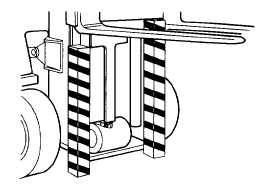| |
TM 10-3930-671-24
Hydraulic Sump Fluid Level Check
Correct fluid level is important for proper hydraulic
system operation:
•
Low fluid level can cause pump damage.
•
Overfill can cause loss of fluid or lift
system malfunction.
•
Because of the expansion of fluid as its
temperature rises, it is preferable to check
the fluid level at operating temperature
(after approximately 30 minutes of truck
operation).
1.
Check the hydraulic sump tank fluid level daily.
2.
To check fluid level, park truck on a level surface
and apply the parking brake. Put upright in a
vertical position and lower fork carriage fully
down.
3.
Pull the dipstick out, wipe it with a clean wiper,
and reinsert it fully into the dipstick tube.
Remove the dipstick and check the oil level.
4.
Keep the oil level above the LOW mark on the
dipstick by adding recommended hydraulic fluid
only as required. DO NOT OVERFILL.
5.
Check the PM time interval (operating hours) or
the condition of the hydraulic fluid (age, color,
clarity, contamination, etc.) to determine if it
needs to be changed. Change (replace) the oil,
as necessary.
Refer to Section 2.1, Service Specifications, for hydraulic
oil specifications.
Hydraulic Fluid & Filter Change
It is recommended to:
•
Drain and replace the hydraulic sump fluid
every 2000 operating hours, or sooner, as
required.
•
Replace the hydraulic oil filter at every oil
change, or every 500 hours, whichever
occurs sooner.
•
Replace the sump tank breather/fill cap
every 500 operating hours, or as required.
There is no drain plug in the hydraulic sump tank. The
hydraulic fluid can be changed by one of the following
methods:
1.
Removal of the hydraulic sump tank cover
assembly and pumping the fluid out by suction
using a separate pump and hose.
2.
By connecting a quick-disconnect coupling to the
test port and pumping the fluid out using the
truck hydraulic system. This method may be
used most easily and satisfactorily for routine
changes of the fluid.
Refer to Section 10. 1, Main hydraulic System
Maintenance, for additional information.
Hydraulic Oil Filter
Remove and replace the hydraulic system fluid filter per
recommended PM schedule, or as may be required by
truck operating conditions and usage.
Refer to Section 10. 1, Main Hydraulic System
Maintenance, for additional information.
Sump Tank Breather Maintenance
1.
Remove the sump tank breather/fill cap and
inspect for excessive (obvious) contamination
and damage.
2.
Replace the breather/fill cap, per recommended
PM schedule, or as required by operating
conditions.
Refer to Section 10.1, Main Hydraulic System
Maintenance, for additional information.
Access To the Transaxle
Transaxle Fluid
An upright or carriage can move unexpectedly. Chain or
block the carriage and each rail. FAILURE TO FOLLOW
THIS WARNING CAN RESULT IN SERIOUS INJURY
NOTE
If you are unfamiliar with this procedure, please refer to
Section
3.3,
Machine
Jacking
and
Blocking,
for
information on blocking the upright in raised position.
The best method to use for reaching the transaxle
checkpoints (oil level/filler plug and drain plugs) is
dependent upon the style of upright, carriage, and
attachments on your truck. One method is to raise the
upright carriage to provide easier access to the transaxle
from the front. See illustration.
Apply the parking brake and block the wheels. Be sure to
put blocking under the carriage and upright rails.
F-52
|



